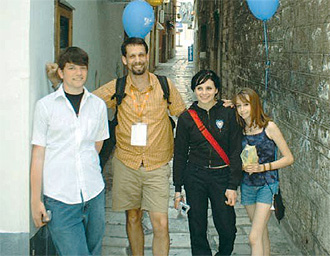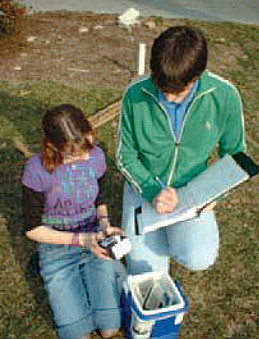Student Features
The Globe Program: Science in the Sunshine
12.18.03
| Who are NASA's Earth Explorers? The elementary school student wondering how El Niño will affect tomorrow's weather. The scientist studying connections between ozone and climate change. And the farmer using satellite pictures to keep track of crops. All of these people are Earth Explorers -- they are all curious about the Earth system. This monthly series will introduce you to NASA Earth Explorers, young and old, with many backgrounds and interests. |

|
(From left to right) Chris Hanawalt, Frank Niepold, Melanie Benetato and Gianna D'Emilio travel to Croatia to present their findings at an international GLOBE conference. Photograph by Frank Niepold |
They all agreed to go outside and measure the air quality. To do this, they would go out every sunny day and measure the amount of sunlight reaching the ground.
The hard work paid off when the group was one of 12 teams selected to go to the 2003 GLOBE Learning Expedition. GLOBE is an organization of students and teachers around the world who collect and share data about the environment. The GLOBE Learning Expedition was held in Sibenik, Croatia.
Students and teachers from 22 countries came to the conference. Everyone explained their work and also talked about how they could work together to collect more data.

|
D'Emilio and Hanawalt take aerosol measurements using a hand-held sun photometer. Photograph by Charles Kellett |
David Brooks also heard about the project. Brooks is a scientist at Drexel University in Philadelphia. He suggested that they also test how accurately a NASA satellite can measure aerosols.
Brooks is in charge of a GLOBE project that has developed a "sun photometer." This instrument measures aerosols. First, D'Emilio's team took daily measurements with the instrument. Later, they studied the data and wrote a report.
The team included fellow student Jordan Glist and two recent Burke graduates, Chris Hanawalt and Melanie Benatato.
What did they find out?
Their data showed that the instruments on the Terra satellite did a good job over uniform surfaces like oceans. It did not do as well over changing surfaces like cities.
Another Burke team is being formed to continue the project in 2004. That's when NASA's Aura satellite will be launched. Aura will also have instruments that measure aerosols. A school in Bremen, Germany, is planning to collect similar data.
Related Resources
GLOBE
http://www.globe.gov
S'COOL
http://scool.larc.nasa.gov
Adapted with permission: ChemMatters magazine © American Chemical Society 2003
http://www.chemistry.org/education/chemmatters.html